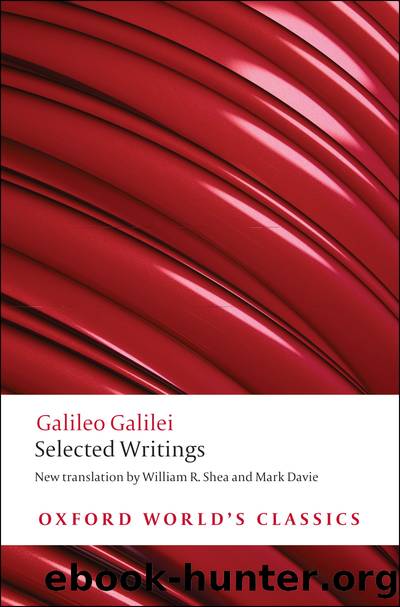Selected Writings (Oxford World's Classics) by Galileo Galilei & William R. Shea & Mark Davie

Author:Galileo Galilei & William R. Shea & Mark Davie
Language: eng
Format: epub
Publisher: Oxford University Press
Published: 2012-11-15T00:00:00+00:00
SAGREDO. I see all that. But if there are such mountains near the circumference, itâs certainly true that the Sunâs rays will fall more directly on them than on the inclination of a polished surface; but itâs also true that the valleys between these mountains would all be dark, because of the very long shadows the mountains would cast at such a time. But the parts near the centre, even if they were also full of mountains and valleys, would not have shadows because the Sun would be much higher in the sky. So the parts in the centre should shine much more brightly than those at the edge which would have as much shadow as light; and yet no such difference is apparent.
SIMPLICIO. I was just thinking of the same difficulty.
SALVIATI. Isnât it remarkable how much more readily signor Simplicio grasps the difficulties which support Aristotleâs view than he does their solutions? But I think he sometimes deliberately keeps quiet about them; and in the present case, since he was able to see the objection by himselfâwhich is quite an ingenious oneâI canât believe he hasnât also spotted the reply. So let me try to winkle it out of him, so to speak. Tell me then, signor Simplicio: do you think it is possible for there to be shadow in a place exposed to the Sunâs rays?
SIMPLICIO. I think not, in fact Iâm sure of it: the Sun is the greatest luminary which scatters the darkness with its rays, so anywhere touched by the Sunâs rays cannot possibly remain dark. Besides, we have the definition that tenebrae sunt privatio luminis: darkness is the absence of light.*
SALVIATI. Therefore, when the Sun beholds the Earth, the Moon or any other opaque body, it never sees any of their parts that are in shadow, since it has no eyes to see apart from its light-giving rays; and hence any observer who was on the Sun would never see anything that was in shadow, because his visual rays* would always accompany the Sunâs rays of light.
SIMPLICIO. Thatâs very true, beyond contradiction.
SALVIATI. But when the Moon is in opposition to the Sun, what difference is there between the line of your visual rays and that of the Sunâs rays?
SIMPLICIO. Now I understand; you mean that since the rays of our vision always follow the same lines as the Sunâs rays, we canât see any of the valleys of the Moon that are in shadow. Please donât think that I am pretending or dissembling with you; I give you my word as a gentleman that this reply had not occurred to me, and I doubt whether I would have found it without your help, or at least without thinking about it at length.
SAGREDO. The solution to this latest difficulty which you have arrived at between you has convinced me as well. But at the same time, this notion of visual rays accompanying the Sunâs rays has raised another doubt in my mind on the other side of the argument.
Download
This site does not store any files on its server. We only index and link to content provided by other sites. Please contact the content providers to delete copyright contents if any and email us, we'll remove relevant links or contents immediately.
Invention by James Dyson(725)
Thinking Better by Marcus du Sautoy(680)
The Ten Equations That Rule the World by David Sumpter(674)
Concepts of Space by Jammer Max;(656)
God and the Multiverse by Victor J. Stenger(632)
Wanting by Luke Burgis(626)
Merchants of Doubt by Erik M. Conway(625)
How We Got to Now by Steven Johnson(602)
Factfulness by unknow(562)
The Surrender Experiment by Michael A. Singer(539)
The Smallest Lights in the Universe by Sara Seager(514)
On Creativity by Bohm David(490)
Floods, Famines, and Emperors: El Nino and the Fate of Civilizations by Brian Fagan(481)
Ancient Knowledge Networks by Eleanor Robson;(480)
Why Birds Matter by University of Chicago Press(471)
The Scientist and the Psychic by Christian Smith(463)
The Science of Being Lucky: How to Engineer Good Fortune, Consistently Catch Lucky Breaks, and Live a Charmed Life by Peter Hollins(462)
The Oxford Handbook of Philosophy of Mathematics and Logic by Stewart Shapiro(452)
Flood by Design (Design Series) by Mike Oard(428)
